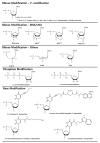Nucleic Acid aptamers: new methods for selection, stabilization, and application in biomedical science
- PMID: 24404332
- PMCID: PMC3879913
- DOI: 10.4062/biomolther.2013.085
Nucleic Acid aptamers: new methods for selection, stabilization, and application in biomedical science
Abstract
The adoption of oligonucleotide aptamer is well on the rise, serving an ever increasing demand for versatility in biomedical field. Through the SELEX (Systematic Evolution of Ligands by EXponential enrichment), aptamer that can bind to specific target with high affinity and specificity can be obtained. Aptamers are single-stranded nucleic acid molecules that can fold into complex threedimensional structures, forming binding pockets and clefts for the specific recognition and tight binding of any given molecular target. Recently, aptamers have attracted much attention because they not only have all of the advantages of antibodies, but also have unique merits such as thermal stability, ease of synthesis, reversibility, and little immunogenicity. The advent of novel technologies is revolutionizing aptamer applications. Aptamers can be easily modified by various chemical reactions to introduce functional groups and/or nucleotide extensions. They can also be conjugated to therapeutic molecules such as drugs, drug containing carriers, toxins, or photosensitizers. Here, we discuss new SELEX strategies and stabilization methods as well as applications in drug delivery and molecular imaging.
Keywords: Aptamer; Drug delivery system; Imaging; Modification; SELEX; Stabilization.
Figures




References
-
- Barciszewski J., Medgaard M., Koch T., Kurreck J., Ermann V. A. Locked nucleic acid aptamers. Methods Mol. Biol. (2009);535:165–186. - PubMed
Publication types
LinkOut - more resources
Full Text Sources
Other Literature Sources

